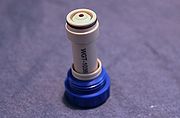Difference between revisions of "OroboPOS"
| Line 5: | Line 5: | ||
|product id=26000-01 | |product id=26000-01 | ||
|product type=O2k, OroboPOS | |product type=O2k, OroboPOS | ||
|info=[[MiPNet19.18B POS-Service]], [[ | |info=[[MiPNet19.18B POS-Service]], [[Gnaiger 1983 POS]] | ||
|product image=[[Image:OroboPOS sensor head.jpg|right|180px]] | |product image=[[Image:OroboPOS sensor head.jpg|right|180px]] | ||
}} | }} | ||
| Line 19: | Line 19: | ||
== POS service and membrane mounting == | == POS service and membrane mounting == | ||
>> [[MiPNet19.18B POS-Service |O2k-Manual for OroboPOS Service]] | :>> [[MiPNet19.18B POS-Service |O2k-Manual for OroboPOS Service]] | ||
:>> [[OroboPOS-Service Kit]] | |||
>> [[OroboPOS-Service Kit]] | |||
== POS calibration and SOP == | |||
:>> [[MiPNet19.18D O2k-Calibration]] | |||
:>> [[MiPNet06.03 POS-Calibration-SOP]] | |||
== References == | == References == | ||
Revision as of 00:17, 20 May 2015
OroboPOS
| Description | The OroboPOS is a polarographic oxygen sensor (POS), with an amperometric mode of operation. The OroboPOS meets the highest quality criteria in terms of linearity, stability and sensitivity of the signal. The Clark type polarographic oxygen sensor (POS) remains the gold standard for measuring dissolved oxygen in biomedical, environmental and industrial applications over a wide dynamic oxygen range.
It consitsts of a gold cathode, a silver/silverchloride anode and a KCl electrolyte reservoir separated from the sample by a 25 µm membrane (FEP). The main body of the OroboPOS is made of PEEK. With application of a polarization voltage (0.8 V), a current is obtained as an amperometric signal, which is converted to a voltage. |
|---|---|
| Product ID | 26000-01 |
| Type | O2k, OroboPOS |
| Link | MiPNet19.18B POS-Service, Gnaiger 1983 POS |
| Image |
Specifications
From nM to mM O2 - a million-fold dynamic range: The dynamic range of oxygen measurement spans from air saturation (about 200 µM) to the normoxic intracellular range (10-30 µM) and severe hypoxia (<0.1 µM), but also to hyperoxia (oxygen saturation: c. 1 mM). In measurements of cell respiration in conjunction with the Titration-Injection microPump TIP2k, allow accurate steady-state measurement of oxgen levels and respiration with resolution of better than ±1 nM O2.
Shipment
- O2k-Core: 2 OroboPOS are included and shipped in the O2k-Service Box. A spare (third) OroboPOS may be added to the items ordered with the O2k-System.
OroboPOS are protected in a transparent perspex vial screwed onto a blue POM base, with the OroboPOS-Membrane Ring arrested on the POS shaft between the POM base and the thicker part of the POS head which holds an O-ring\Viton\8x1 mm.
POS service and membrane mounting
POS calibration and SOP
References
- Gnaiger E, Forstner H, eds (1983) Polarographic Oxygen Sensors. Aquatic and Physiological Applications. Springer, Berlin, Heidelberg, New York: 370 pp.
- Gnaiger E (2001) Bioenergetics at low oxygen: dependence of respiration and phosphorylation on oxygen and adenosine diphosphate supply. Respir Physiol 128: 277-297.
- Gnaiger E (2008) Polarographic oxygen sensors, the oxygraph and high-resolution respirometry to assess mitochondrial function. In: Mitochondrial Dysfunction in Drug-Induced Toxicity (Dykens JA, Will Y, eds) John Wiley: 327-352.






